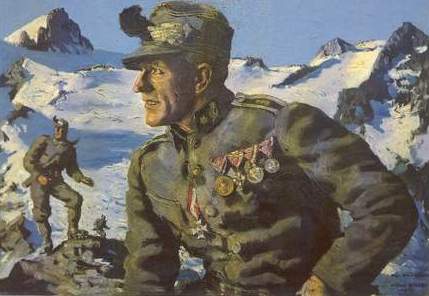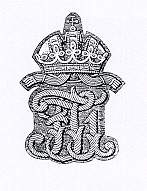|
Formation and Pre-war History
The creation of the Tyrolean and Voralberg Landesschützen units was originally ordered in December 1870 at a strength of ten battalions bearing the numbers 1 to 10 ( from 1889 I to X) with a projected wartime establishment of four field and one replacement companies each. The yearly recruiting contingent was set at 413 men per year. According to the statute of 1874, every battalion had in peace-time four field companies.
being of predominantly German nationality the command language of the Landesschützen was German and the title of the private soldier was initially Schütze which in 1894 was changed to Landesschütze.
The strength of a battalion was comparable to that of common army Feldjäger battalion.
The ten battalions were named and garrisoned as follows:
|
|
Landesschützen-Bataillon
Unter-Inn-Thal Nr.I
Landesschützen-Bataillon
Innsbruck-Wipp-Thal Nr.II
Landesschützen-Bataillon
Ober-Inn-Thal Nr.III
Landesschützen-Bataillon
Ober-Etsch-Thal Nr.IV
Landesschützen-Bataillon
Etsch und Fleims-Thal Nr.V
Landesschützen-Bataillon
Puster-Thal Nr.VI
Landesschützen-Bataillon
Noce-Avisio Nr.VII
Landesschützen-Bataillon
Trient-Valsugana Nr.VIII
Landesschützen-Bataillon
Roveredo-Sarca Nr.IX
Landesschützen-Bataillon
Voralberg Nr.X |
Schwaz
Innsbruck
Imst
Meran
Bozen
Bruneck
Mezzolombardo
Trient
Riva
Bregenz (1901 Imst) |
|
On the 1st of
May 1893, the ten battalions were formed into three regiments: Tiroler
Landesschützenregiment Nr.I with the regimental staff in Innsbruck,
Tiroler Landesschützenregiment Nr.II with regimental staff in Bozen and
Tiroler Landesschützenregiment Nr.III with regimental staff in Trient.
The regiments were formed from the following battalions:
|
|
Tiroler
Landesschützenregiment Nr.I
Tiroler
Landesschützenregiment Nr.II
Tiroler
Landesschützenregiment Nr.III
|
Landesschützen-Bataillon
Nr.I, II, III and X
Landesschützen-Bataillon
Nr.IV, V and VI
Landesschützen-Bataillon
Nr.VII, VIII and IX
|
|
Tiroler
Landesschützenregiment Nr.III was disbanded in 1901 and its battalions
transferred to the II. regiment. At the same time the I. and II.
regiments were reorganised: The II. and IV. battalions of the I.
regiment were disabanded and the III. battalion was renamed as the II.
The III. battalion from the k.k.Landwehrinfanterieregiment Nr.2 became
the new III. battalion. The newly organised regiments were now known as
the k.k.Tiroler Landesschützenregiment Innsbruck Nr.I and k.k.Tiroler
Landesschützenregiment Bozen Nr.II respectively and were brigaded
together in the k.k.88.Landesschützenbrigade which had its headquarters
in Bozen. On the 1st May 1906 the two regiments of landesschützen were
officially recognised as high mountain troops and following this the
I.regiment moved to and received the name k.k.Tiroler
Landesschützenregiment Trient Nr.I. Finally on the 1st of March 1909
the III.regiment was reformed as the k.k.Tiroler Landesschützenregiment
Innichen Nr.III.
|
|
The First World War
Mobilisation found all three
regiments of Landesschützen serving in Feldmarschalleutnant Heinrich
Tschurtschenthaler von Helmheim's 44.Landwehr-Infanterie-Division. The
1st regiment was serving in Generalmajor Ludwig Goiginger's
122.Landwehr-Infanterie-Brigade and the other two regiments under
command of Generalmajor Karl Georgi's 88.Landesschützen-Brigade. As a
part of XIV.Korps (General der Infanterie Erzherzog Joseph Ferdinand)
and General der Kavallerie Rudolf Ritter von Brudermann
's 3.Armee, the specialised high mountain warfare trained soldiers found
themselves not fighting in the Dolomites or the Puster Valley but on the
relatively flat Galician plains of what is now the Western Ukraine. All
three regiments suffered high casualties during that first Summer and
Winter campaign on the Russian front in engagements such as Grodek,
Rawa-Ruska, Przemysl, Limanowa and the especially difficult fighting in
the Carpathian mountains. Following the successful Gorlice-Tarnów
offensive in May 1915 and Italy's subsequent entry into the war later
that month, all three regiments were moved to the Italian front, where
they joined colleagues who had manned the border fortifications since
the outbreak of the war. The regiments fought at the Isonzo, Col di
Lana, the Trentino offensive of 1916 and in many other bitter
engagements during the next three years. The skill and valour of the
three regiments would earn them the name of Kaiserschützen on the 16th January
1917, when Kaiser Karl in recognition of their prowess awarded them this
new designation. Uniquely among the Austro-Hungarian forces, five
officers of the Landesschützen/Kaiserschützen were awarded the
Military Maria Theresa Order - Austro-Hungary's highest award for
valour during the First World War:
|
|
Oberst Robert Freiherr von
Procházka
Oberleutnant Alfred Enrich
Major Konstantin Valentini
Oberleutnant Wilhelm Licka
Leutnant der Reserve Peter
Scheider
|
Kaiserschützenregiment Nr.II
Kaiserschützenregiment Nr.I
Kaiserschützenregiment
Nr.III
Kaiserschützenregiment Nr.I
Kaiserschützenregiment
Nr.III
|
|
-
|
|

|
The illustration to the left depicts Leutnant in der Reserve Peter
Scheider who won his Knight's Cross of the Military Order of Maria
Theresa for the storming of the 2432 metre high Monticello Ridge on the
13th of June 1918 whilst commanding Kaiserschützen of High Mountain
Company 17. This post war oil painting of Scheider by Alfons Walde shows
him wearing the Maria Theresa Order from his second button hole. He was
however not actually awarded the Order until the 31st October 1931 in
the last post war "Promotion" (Number 195). His Golden Bravery
Medal was awarded in November 1918 (P.V.Bl. f. d. k.u.k. Heer
Nr.200 v. 9. Nov. 1918.)
|
|
--
|
|
Additionally a further 130
officers, NCOs and Schützen were awarded the Golden Bravery Medal with
a further 2797 being awarded the 1st class Silver Bravery Medal.
|
Regimental Commanders 1914-1918: The commanders of the three
individual regiments during the First World War were as follows:
| - |
|
| KSchR.I: |
|
| Oberst Adolf Słoninka von Hołodów |
Aug 14 - Mar 15 |
| Major Ludwig Nechi (Interim) |
Mar 15 - Jun 15 |
| Oberst Adolf Słoninka von Hołodów |
Jun 15 - Mar 16 |
| Oberstleutnant/Oberst Rudolf Florio |
Mar 16 - Aug 18 |
| Oberstleutnant/Oberst Ludwig Nechi |
Aug 18 - Nov 18 |
| KSchR.II: |
|
| Oberstleutnant/Oberst Josef Stiller |
Nov 12 - Oct 14 |
| Oberstleutnant Theodor Spiegel |
Oct 14 - Nov 14 |
| Oberst Hugo Schönherr |
Nov 14 - Dec 14 |
| Oberstleutnant/Oberst Friedrich Ritter von Mülleitner |
Dec 14 - Mar 17 |
| Oberstleutnant/Oberst Emil Busch |
Mar 17 - Nov 18 |
| KSchR.III: |
|
| Oberstleutnant/Oberst Hugo Schönherr |
Apr 14 - Sep 14 |
| Oberstleutnant Theodor Spiegel |
Sep 14 - Oct 14 |
| Oberst Josef Stiller |
Oct 14 - Dec 14 |
| Oberstleutnant/Oberst Josef Hadaszczok |
Dec 14 - Mar 18 |
| Oberst Gabriel Graf von Gudenus |
Mar 18 - Nov 18 |
|
|
The war's end found the majority of all three regiments entering Italian
captivity and thus ended the relatively short existence of Austria's
first and most famous mountain troops. During the course of the First
World War the total fatal casualties suffered by the three regiments
came to some 15,500.
|
|
|
Insignia
The most distinguishing marks of the Landesschützen/Kaiserschützen
were the wearing of a cock feather plume or "Spielhahnstoß" on
the left side of the cap and the Edelweiß badge worn on the collar patch.
Both of these distinctions had been introduced in June 1907. The badge for
NCOs and Schützen was in metal and embroidered on grass-green badge cloth
for commissioned officers. The collar patches were grass-green and the
button colour was white. Uniquely Landesschützen commissioned officers
were further distinguished by the wearing of shoulder straps. On the
service dress tunic these were grass-green cloth edged with silver lace
and surmounted by a Kaiser's cypher and crown. The illustration above
shows a major's left hand patch. This illustrates well the contrasting
star and lace colours of a field officer. Additionally commissioned
officers and the senior officer aspirants (Fähnrich) wore a
gold-plated tombac Imperial cypher instead of the normal circular
bullion badge on the field cap.
|
|
-
|
|
|
Shoulder strap of a Lieutenant or Captain as worn on the service dress
blouse. The strap is made of grass-green badge cloth 5cm in width with a
gold embroidered Kaiser's cypher and crown on a red silk underlay. The
strap of the field officers was 6cm wide with a larger cypher and crown.
|
|
-
|
|
|

|
The Cypher as worn by Commissioned Officers and Senior Officer Aspirants (Fähnrich)
on the pike grey field service dress Kappe and the black service dress
Kappe. It was manufactured in matt gold embroidery for officers and in
yellow silk for the Fähnrich on a grass-green badge cloth underlay with a
height of 4.5cm and a width of 3cm.
|


